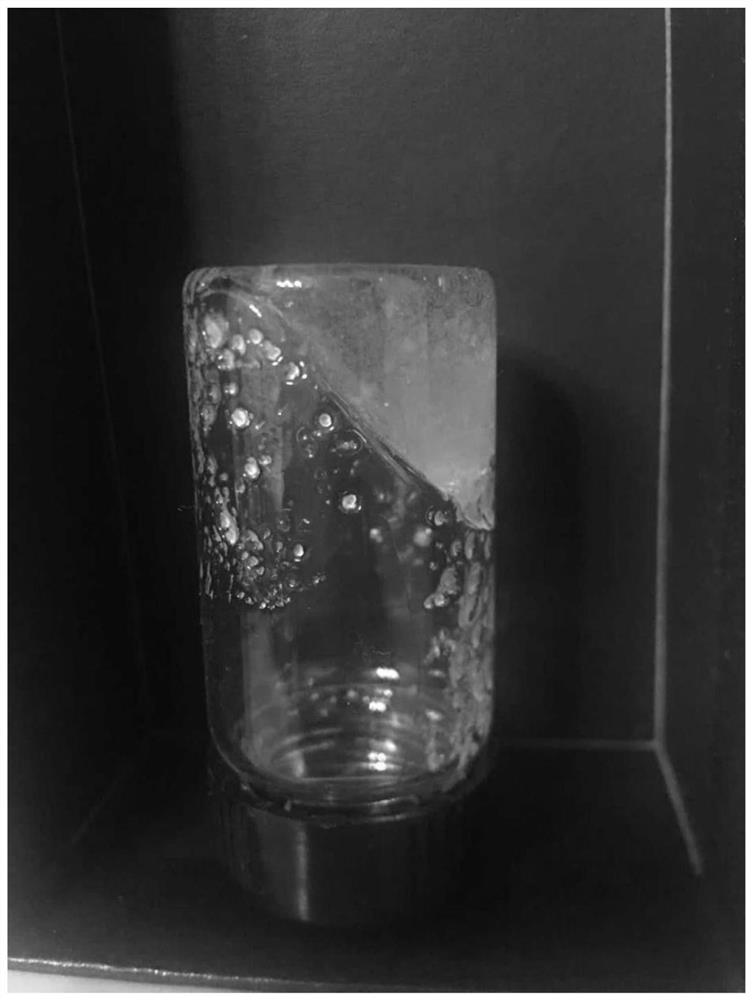A kind of preparation method and application of pure inorganic colloid
A technology of inorganic glue and colloid, which is applied in the direction of solid electrolyte, electrolyte immobilization/gelation, electrolyte, etc., can solve the problems that the normal operation of power equipment cannot be guaranteed, the polymer cannot withstand high temperature, and the battery temperature rises. Achieve the effect of maintaining ion transmission ability and solving high temperature stability problems
- Summary
- Abstract
- Description
- Claims
- Application Information
AI Technical Summary
Problems solved by technology
Method used
Image
Examples
Embodiment 1
[0015] (1) Add 0.2mol zinc chloride, 0.2mol zinc bromide and 0.2mol zinc acetate to 10g deionized water in sequence, heat to 120°C to dissolve, and naturally cool to room temperature to obtain a total concentration of 60mol kg -1 Zinc chloride-zinc bromide-zinc acetate aqueous colloid.
[0016] (2) Gained colloid is placed in a glass bottle, and it can be seen that there is no fluidity after inversion, see figure 1 , so it can be known that it has properties similar to hydrogels.
[0017] (3) Add 0.2mol of zinc chloride, 0.2mol of zinc bromide and 0.2mol of zinc acetate into 10g of deionized water in sequence, heat to 120°C to dissolve, pour the flowable mixed system on the polytetrafluoroethylene film, and Cover the second layer of polytetrafluoroethylene film, press an iron block, and cool to obtain a gelatinous sheet with a thickness of 0.1 mm.
[0018] Its conductivity measured at room temperature is 10 -3 S m -1 . The conductivity measured at 100°C is 2×10 -3 S m -...
Embodiment 2
[0022] (1) Add 0.3mol zinc chloride, 0.3mol zinc bromide and 0.4mol zinc acetate to 10g deionized water in sequence, heat to 130°C to dissolve, and naturally cool to room temperature to obtain a total concentration of 100mol kg -1 Zinc chloride-zinc bromide-zinc acetate aqueous colloid.
[0023] (2) The obtained jelly was placed in a glass bottle, and no fluidity was seen after inversion.
[0024] (3) Add 0.3mol zinc chloride, 0.3mol zinc bromide and 0.4mol zinc acetate to 10g deionized water in turn, heat to 130°C to dissolve, pour the flowable mixed system on the polytetrafluoroethylene film, and Cover the second layer of polytetrafluoroethylene film, press an iron block, and cool to obtain a gelatinous sheet with a thickness of 0.1mm. Its conductivity measured at room temperature is 10 -4 S m -1 . The conductivity measured at 100°C is 2*10 -4 S m -1 . Test method is the same as embodiment 1.
[0025] (4) The zinc negative electrode, the colloidal sheet and the graph...
Embodiment 3
[0027] (1) Add 0.2mol of zinc chloride, 0.2mol of zinc bromide and 0.2mol of zinc acetate to 10g of deionized water in sequence, heat to 120°C to dissolve, and naturally cool to room temperature to obtain a total concentration of 60mol kg -1 Zinc chloride-zinc bromide-zinc acetate aqueous colloid.
[0028] (2) Put the obtained jelly in a glass bottle, and it can be seen that there is no fluidity after inversion.
[0029] (3) Add 0.2mol of zinc chloride, 0.2mol of zinc bromide and 0.2mol of zinc acetate into 10g of deionized water in sequence, heat to 120°C to dissolve, pour the flowable mixed system on the polytetrafluoroethylene film, and Cover the second layer of polytetrafluoroethylene film, press an iron block, and cool to obtain a gelatinous sheet with a thickness of 0.1mm. Its conductivity measured at room temperature is 10 -3 S m -1 . The conductivity measured at 100°C is 2*10 -3 S m -1 . Test method is the same as embodiment 1.
[0030] (4) The titanium foil cu...
PUM
 Login to View More
Login to View More Abstract
Description
Claims
Application Information
 Login to View More
Login to View More - R&D
- Intellectual Property
- Life Sciences
- Materials
- Tech Scout
- Unparalleled Data Quality
- Higher Quality Content
- 60% Fewer Hallucinations
Browse by: Latest US Patents, China's latest patents, Technical Efficacy Thesaurus, Application Domain, Technology Topic, Popular Technical Reports.
© 2025 PatSnap. All rights reserved.Legal|Privacy policy|Modern Slavery Act Transparency Statement|Sitemap|About US| Contact US: help@patsnap.com

